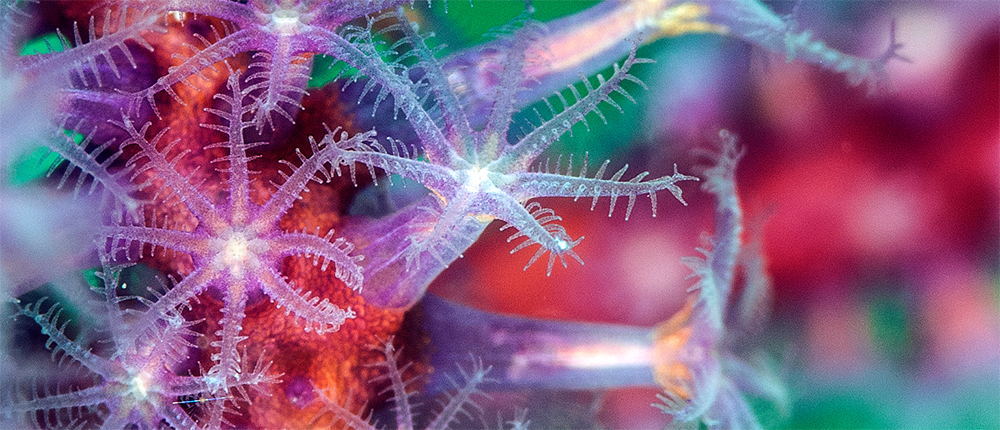Keeping Things Colorful
When a coral reef turns stark white, it raises concerns. This phenomenon, known as coral bleaching, has occurred at a number of places on reefs around the world in the past few years. In most cases, the afflicted reefs eventually recover and the color is restored. The question is, why are some places more susceptible to bleaching, and why has Wakatobi remained highly resistant to this issue?
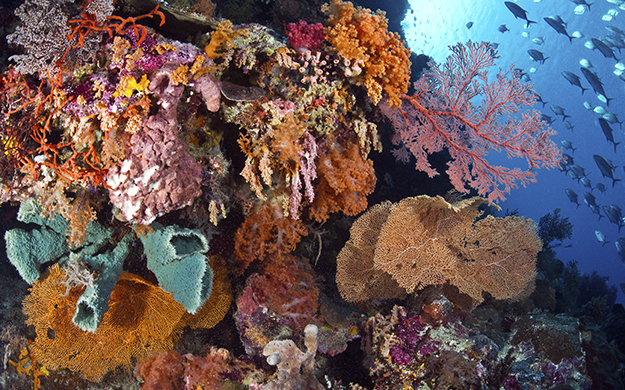
Zooxanthellae algae are pigment cells that take up residence inside the coral’s tissue. It is an innate mixture of these cells that give coral its generous display of color. Photo by Warren Baverstock
Roommates with benefits
To understand why Wakatobi’s reefs remain vital and colorful, let’s start with a brief detour into the biology of coral. Most divers know that corals are actually animals—they just happen to be glued to the reef. Coral polyps are carnivores that can extend tentacles to snare passing morsels, but they are also farmers. The actual coloration of coral most often come not from the polyps, but from the tiny photosynthetic algae known as Zooxanthellae that lives within the coral. These tiny plants are probably the most important drivers of life in the entire reef system.
The actual coloration of coral is most often not from the polyps, but from the photosynthetic algae known as Zooxanthellae, living within the coral.
Zooxanthellae are a highly diverse group of organisms that include several hundreds of species of algae. They may be very coral-specific or at home on multiple types of coral, and two or three species may share a single coral host. The relationship between corals and zooxanthellae is mutually beneficial. The coral provides the algae a protected environment to call home. And in addition to being safe from predation, the zooxanthellae utilizes the coral’s metabolic waste products to fulfill their dietary needs.
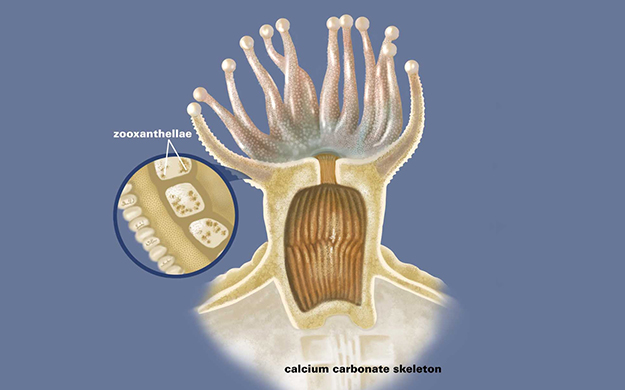
The perfect symbiotic relationship between the zooxanthellae algae and coral polyp facilitates a recycling of nutrients, even in nutrient-poor waters. Image courtesy of Royal Society Biological Sciences
In return for shelter, the algae produce oxygen and supply the coral with glucose, glycerol and amino acids, which are the products of photosynthesis. The coral uses these nutritional compounds to create proteins, fats, and carbohydrates and to produce calcium carbonate, which is vital for creating its reef-building skeleton. This perfect symbiotic relationship between the algae and coral polyp facilitates recycling of nutrients even in nutrient-poor tropical waters. In fact, as much as 90 percent of the organic material photosynthetically produced by the zooxanthellae is transferred directly to the host coral tissue.

As much as 90% of the organic material photo-synthetically produced by zooxanthellae algae is transferred directly to the host coral tissue. The Turbinaria coral here, found at the dive site Roma, grows well in the sun-lit depths. Photo by Glen Cowans
Too hot for comfort
Every species of coral has its comfort zone. Those that live in the extreme tropical zones of Tropical Atlantic/Caribbean, Pacific and Indian Ocean tend to do best when water temperatures hover between 23°– 29° C (73° – 84° F). Things can become problematic for corals when ocean temps heat up beyond this comfort zone. An additional 1° C rise in water temperature above seasonal norms may cause heat-stressed corals to shed their internal crops of symbiotic algae, because as the heat is turned up, the algae responds by producing toxic compounds. In addition to eliminating a primary food source, this biological eviction causes the corals to lose their colors, revealing the stark-white calcium-based structure beneath, and creating the appearance of having been bleached.
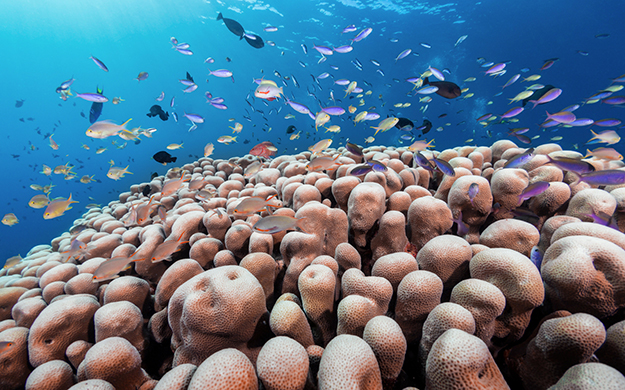
Cooler currents bringing more plankton are clearly appreciated by thriving fish populations as well as the corals themselves. Photo by Marco Fierli, marcof8.com
Bleaching is not necessarily a death sentence for a coral reef. The coral polyps can survive for a period of time without their algae crops by feeding on plankton captured by their tentacles, but this isn’t a balanced diet. If the polyps go for too long without their zooxanthellae partner, the bleaching may prove fatal to some or all members of a coral colony. Yet, a timely drop in water temperature often allows corals to recover from a bleaching event, and in time the colors will return as life gets back to normal.
Reefs In good health With No Coral Bleaching
Fortunately, bleaching has never been and continues to not be an issue for Wakatobi Resort. Our geographical positioning may have something to do with it as we are located outside the cyclone belt and not affected by cyclone activity; additionally, we do not experience extreme seasonal changes in either air or water temperatures.

Hard corals play an important role in reef ecosystems as hiding places for fish and invertebrates, and filters for organic material. Photo by Walt Stearns
And there is another factor that can contribute to bleaching, and that’s the overall health of the corals themselves. Just as a person who is in good overall health may be less susceptible to seasonal allergies and infirmities, corals that are not stressed by poor water quality or human impacts stand a better chance of tolerating the occasional bout of warmer water without incident.
“I have spent a lot of time diving in some of the worlds favorite spots, but I can’t think of another place where I saw so much life in such good condition as at Wakatobi.” ~Simon Bowen
Thanks to efforts such as our Collaborative Reef Conservation Program, the reefs surrounding Wakatobi remain in excellent health. Drop in at any dive site around Wakatobi Resort and you will find thriving reefs covered in rich growths of vibrant hard and soft corals. “We did not witness any bleaching, rather tons of color and things we would never see in other destinations,” said James and Misty Newton, who visited in August of 2019. “We loved it so much we can’t wait to go back to Wakatobi,” Misty added.
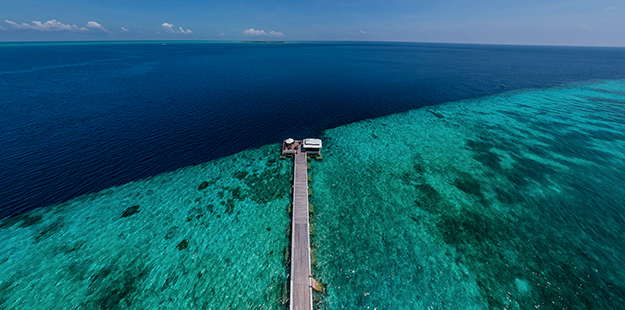
Wakatobi’s House Reef and surrounding reefs are some of the healthiest on the planet. Isn’t it time to see for yourself? Photo by Didi Lotze
“The hard corals on Wakatobi’s reefs show strong coloration, which is an indicator of excellent health,” said Simon Bowen. “I have spent a lot of time diving in some of the worlds favorite spots, but I can’t think of another place where I saw so much life in such good condition as at Wakatobi. I was told that the reefs had been getting healthier and healthier as time has passed. Certainly what I saw is a testament to this,” he said.
We’re thankful that our conservation efforts continue to bear fruit. To this end, the Wakatobi Collaborative Reef Conservation Program is now one of the world’s largest privately-funded marine protection programs and one of the largest marine protected areas. We will continue to do everything in our power to ensure that our reefs remain healthy and vibrant, not only for our enjoyment but for that of future generations.
Here’s a short underwater tour of our reefs that will both relax and inspire – enjoy!
Ready for the Great Wakatobi Reef Experience? We’re easy to reach via direct charter flights from Bali to our own airstrip. Learn more here.
Contact us at office@wakatobi.com or complete a quick trip inquiry at wakatobi.com.


